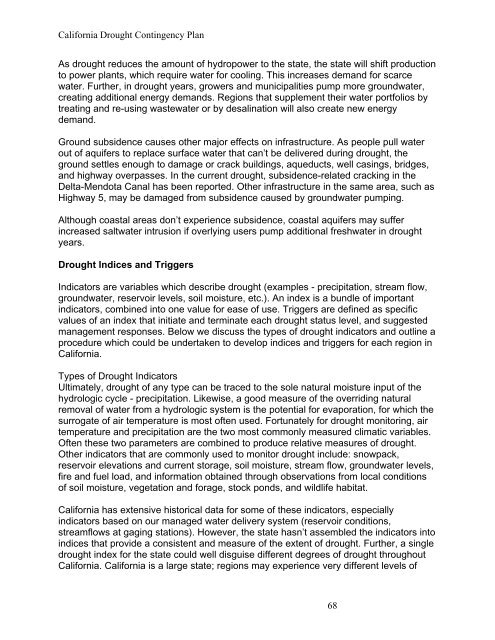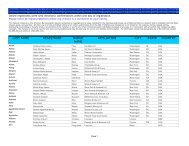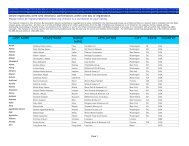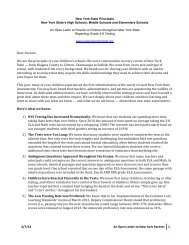Final_CA_Drought_Contingency_Plan-11-18-2010a
Final_CA_Drought_Contingency_Plan-11-18-2010a
Final_CA_Drought_Contingency_Plan-11-18-2010a
Create successful ePaper yourself
Turn your PDF publications into a flip-book with our unique Google optimized e-Paper software.
California <strong>Drought</strong> <strong>Contingency</strong> <strong>Plan</strong>As drought reduces the amount of hydropower to the state, the state will shift productionto power plants, which require water for cooling. This increases demand for scarcewater. Further, in drought years, growers and municipalities pump more groundwater,creating additional energy demands. Regions that supplement their water portfolios bytreating and re-using wastewater or by desalination will also create new energydemand.Ground subsidence causes other major effects on infrastructure. As people pull waterout of aquifers to replace surface water that can’t be delivered during drought, theground settles enough to damage or crack buildings, aqueducts, well casings, bridges,and highway overpasses. In the current drought, subsidence-related cracking in theDelta-Mendota Canal has been reported. Other infrastructure in the same area, such asHighway 5, may be damaged from subsidence caused by groundwater pumping.Although coastal areas don’t experience subsidence, coastal aquifers may sufferincreased saltwater intrusion if overlying users pump additional freshwater in droughtyears.<strong>Drought</strong> Indices and TriggersIndicators are variables which describe drought (examples - precipitation, stream flow,groundwater, reservoir levels, soil moisture, etc.). An index is a bundle of importantindicators, combined into one value for ease of use. Triggers are defined as specificvalues of an index that initiate and terminate each drought status level, and suggestedmanagement responses. Below we discuss the types of drought indicators and outline aprocedure which could be undertaken to develop indices and triggers for each region inCalifornia.Types of <strong>Drought</strong> IndicatorsUltimately, drought of any type can be traced to the sole natural moisture input of thehydrologic cycle - precipitation. Likewise, a good measure of the overriding naturalremoval of water from a hydrologic system is the potential for evaporation, for which thesurrogate of air temperature is most often used. Fortunately for drought monitoring, airtemperature and precipitation are the two most commonly measured climatic variables.Often these two parameters are combined to produce relative measures of drought.Other indicators that are commonly used to monitor drought include: snowpack,reservoir elevations and current storage, soil moisture, stream flow, groundwater levels,fire and fuel load, and information obtained through observations from local conditionsof soil moisture, vegetation and forage, stock ponds, and wildlife habitat.California has extensive historical data for some of these indicators, especiallyindicators based on our managed water delivery system (reservoir conditions,streamflows at gaging stations). However, the state hasn’t assembled the indicators intoindices that provide a consistent and measure of the extent of drought. Further, a singledrought index for the state could well disguise different degrees of drought throughoutCalifornia. California is a large state; regions may experience very different levels of68






